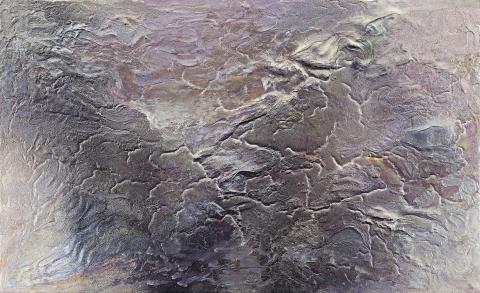DAWN BEAUTY, 1999
JULES OLITSKI
synthetic polymer paint on canvas
103.0 x 167.0 cm
signed, dated and inscribed verso: Jules / Olitski / ’99 / DAWN BEAUTY / 99/00/3
Annandale Galleries, Sydney (label attached verso)
Private collection, Sydney
Widely respected as one of America’s last great modern painters, Jules Olitski was born in Snovsk, Russia (now Ukraine) in 1922, before immigrating with his mother and grandmother to Brooklyn, New York in 1923. Profoundly inspired by the experience of viewing Rembrandt’s oil portraits at the New York Art Fair in 1939, he subsequently embarked upon artistic training at the National Academy of Design, New York from 1939 – 42 and later, at the Ossip Zadkine School and Academie de la Grande Chaumiere in Paris from 1949 – 51. After his first solo show at Galerie Huit in Paris in 1951, Olitski returned to the United States where he continued to employ thick impasto in the manner of Jean Dubuffet and Jean Fautrier, before pioneering the technique of Colour Field painting for which he remains so widely acclaimed today.
Rejecting the gestural brushstroke of the then-prevailing Abstract Expressionists, Olitski and his colleagues Helen Frankenthaler, Ellsworth Kelly and Morris Louis pursued rather ‘post-painterly abstraction’, as coined by art critic Clement Greenberg1 – a style deliberately conceived to eradicate both the illusion of depth and any evidence of the artist’s hand. Dedicated to capturing the evocative power of pure colour, initially Olitski explored staining the canvas surface with paint - directly pouring on the quick-drying acrylic or applying it with rollers, brushes or sponges - until fellow artist Kenneth Noland made the radical suggestion that he experiment with an industrial spray gun to saturate the painting surface. Undoubtedly Olitski’s most important legacy, this process now enabled him to not only completely remove all vestiges of the artist’s touch, but to present paint at its airiest and most dematerialised - thus forcing abstraction to its outer limits by directing the viewer’s attention to the essential qualities of colour itself. Indeed, the breakthrough was considered by many critics to be the apotheosis of the Colour Field movement; as Michael Fried elucidated in his introduction to Olitski’s show at the Corcoran Gallery in 1967, ‘it made possible the interpenetration of different colours, the intensity of each of which appears to fluctuate continuously’. As Fried continues, this created a whole new visual experience in modern art: ‘by atomising colour, Olitski has atomised, even disintegrated the picture surface as well.’2
Universally acclaimed by critics as masterpieces, these ‘sprays’ confirmed Olitski’s stature as a major player in the New York avant-garde of the sixties and accordingly, he was selected to represent the United States, along with Helen Frankenthaler, Ellsworth Kelly and Roy Lichtenstein at the 33rd Venice Biennale in 1966, and in 1969, was the first living artist to be honoured with a solo exhibition at the Metropolitan Museum of Art, New York. By early next decade however, the tide of critical opinion began to turn against him as post-painterly abstraction was challenged by Pop Art, Minimalism and Conceptualism. Undeterred by this change in public taste however, Olitski continued to experiment – his brushwork became increasingly dynamic and his paint application heavier as he moved from a grisaille palette to brighter tones and iridescent finishes, with critics aptly describing his works of the 80s and early 90s as ‘baroque’.
A major departure in a career that had hitherto vehemently rejected any suggestion of imagery or narrative, Dawn Beauty, 1999 is a commanding example of Olitski’s late works in which he notably returns to the natural world for inspiration – specifically, the landscapes near his summer home in New Hampshire and his winter house in the Florida Keys. A deeply spiritual man (as witnessed by the titles of his works often drawn from Hebrew texts), Olitski repeatedly referred to his life as a miracle and embraced the practice of regular prayer and thanksgiving. Far from bearing any hidden religious meaning however, it is more likely that the present work was conceived in homage to Nature – the dynamic textured surface, shimmering golden palette and dramatic interplay of light and shadow alluding to that beautiful yet fleeting effect of first light. An artist who famously slept through the day and painted by night, certainly Olitski appreciated well the promise of dawn break; as he poignantly reflected, ‘Where I live the Almighty presents me with sunsets and I’m up still working as dawn is breaking, so I have the best rise and set of what He provides…’3
1. Greenberg, C., Post Painterly Abstraction, Los Angeles County Museum of Art and The Contemporary Art Council, Los Angeles, 1964
2. Fried, M., ‘Introduction’ in Jules Olitski: 1963-1967, Corcoran Gallery of Art, Washington D.C., 1967, unpaginated
3. Olitski, J., cited in Wecker, M., ‘Painter Jules Olitski Enjoys a Second Life’ in Forward, 29 October 2012, reproduced online at
VERONICA ANGELATOS
